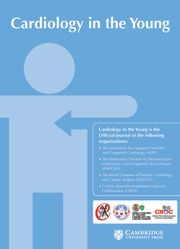No CrossRef data available.
Article contents
Mobile health monitoring of children with CHDs
Published online by Cambridge University Press: 10 October 2024
Abstract
Mobile health has been shown to improve quality, access, and efficiency of health care in select populations. We sought to evaluate the benefits of mobile health monitoring using the KidsHeart app in an infant CHD population.
We reviewed data submitted to KidsHeart from parents of infants discharged following intervention for high-risk CHD lesions including subjects status post stage 1 single ventricle palliation, ductal stent or surgical shunt, pulmonary artery band, or right ventricular outflow tract stent. We report on the benefits of a novel mobile health red flag scoring system, mobile health growth/feed tracking, and longitudinal neurodevelopmental outcomes tracking.
A total of 69 CHD subjects (63% male, 41% non-white, median age 28 days [interquartile range 20, 75 days]) were included with median mobile health follow-up of 137 days (56, 190). During the analytic window, subjects submitted 5700 mobile health red flag notifications including 245 violations (mean [standard deviation] 3 ± 3.96 per participant) with 80% (55/69) of subjects submitting at least one violation. Violations precipitated 116 interventions including hospital admission in 34 (29%) with trans-catheter evaluation in 15 (13%) of those. Growth data (n = 2543 daily weights) were submitted by 63/69 (91%) subjects and precipitated 31 feed changes in 23 participants. Sixty-eight percent of subjects with age >2 months submitted at least one complete neurodevelopment questionnaire.
In our initial experience, mobile health monitoring using the KidsHeart app enhanced interstage monitoring permitting earlier intervention, allowed for remote tracking of growth feeding, and provided a means for tracking longitudinal neurodevelopmental outcomes.
- Type
- Original Article
- Information
- Copyright
- © The Author(s), 2024. Published by Cambridge University Press



